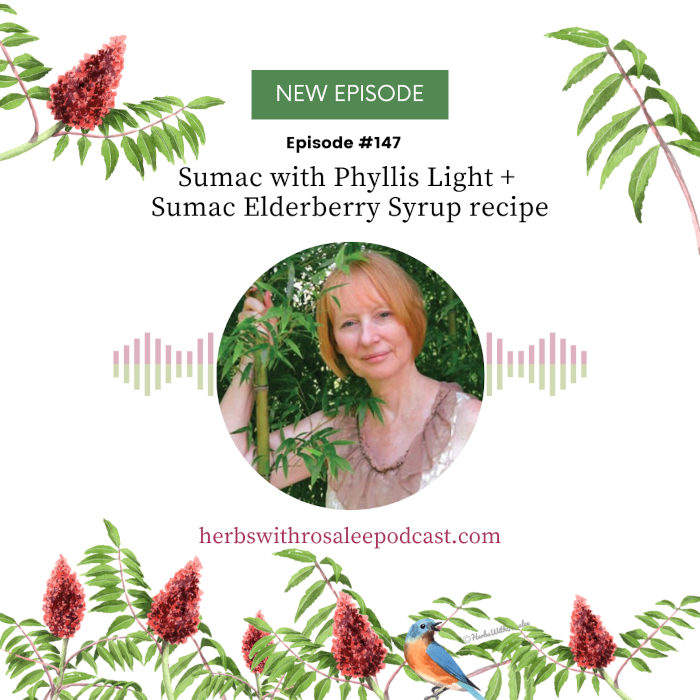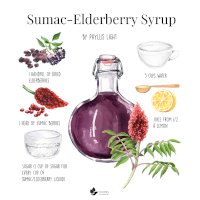Get weekly tips, recipes, and my Herbal Jumpstart e-course! Sign up for free today.
Episode 147: Sumac with Phyllis Light
Share this! |
|

Would you prefer watching or reading this episode? If so, click here for the 'What Is Sumac Good for with Phyllis Light' video and transcript.
Episode Summary
I had such a great time catching up with Phyllis Light in this conversation! Hearing Phyllis’ unique herbal story and her philosophy about herbs and herbalism was a real treat. Plus, she shared such an abundance of information about sumac and its medicinal gifts that I am inspired to start working more with this amazing plant!
Phyllis shared so many ways to work with sumac, including her recipe for Sumac Elderberry Syrup (along with several suggestions of how to use that syrup). You can download a beautifully illustrated recipe card for Phyllis’ syrup in the section below.
You will be amazed at the many medicinal gifts that sumac has to offer! Here are just a few ways that you can work with sumac to benefit your health:
► As a topical remedy for skin issues like fungal rashes and poison ivy
► To help reduce high blood sugar
► As a cooling summer beverage that is high in Vitamin C
And that’s just the tip of the iceberg! I was delighted to learn just how many health challenges can benefit from this incredibly versatile plant. Be sure to tune in to the entire episode for all the details!
By the end of this episode, you’ll know:
► How herbalism and human health have changed in the United States since Phyllis began her herbal journey
► How to distinguish poison sumac from other species of sumac
► How to tell if your dried sumac berries are still medicinally active
► Eighteen - yes, eighteen! - health conditions sumac’s gifts can help with, and six different herbal preparations for sumac
► Why it’s so important to move beyond internet searches when learning about a new plant or herbal treatment
► and so much more…
For those of you who don’t know her, Phyllis D. Light, a fourth generation herbalist and healer, has studied and worked with herbs, foods, and other healing techniques for over 30 years. Her studies in Traditional Southern Folk Medicine began in the deep woods of North Alabama with lessons from her grandmother, whose herbal and healing knowledge had its roots in her Creek/Cherokee heritage. Phyllis’ studies continued as an apprentice with the late Tommie Bass, a nationally renowned folk herbalist from Sand Rock, Alabama. She is the director of the Appalachian Center for Natural Health in Arab, Alabama, which offers both online classes and in-person classes. She is also on the faculty of the Matthew Wood Institute of Herbalism. Phyllis is the author of Southern Folk Medicine, Healing Traditions from Appalachian Fields and Forests published by North Atlantic.
I can’t wait to share our conversation with you today!
What You'll Learn from This Episode
- [01:10] Introduction to Phyllis Light
- [03:40] How Phyllis found her herbal path
- [16:53] How to distinguish poison sumac from other species of sumac
- [18:26] Varieties of sumac that grow in Phyllis’ bioregion
- [20:53] How to tell if your dried sumac berries are still medicinally active
- [22:05] Harvest, drying, and storage tips for sumac berries
- [22:54] Medicinal benefits of sumac
- [37:52] Sumac elderberry syrup
- [46:02] Phyllis’ current herbal projects
- [47:08] How herbs give Phyllis hope
- [56:07] Herbal tidbit
Get Your Free Recipe!
An immune-boosting syrup that can be canned and enjoyed over the long winter months.
Ingredients:
- 1 head of sumac berries
- 1 handful of dried elderberries
- 1 cup of sugar for every cup of sumac/elderberry liquid
- Juice of ½ a lemon
- 5 cups of water
Directions:
- Bring one head of sumac and a handful of elderberries to a boil in 5 cups of water. Reduce to a simmer for 5 minutes. Turn off heat and let sit for 10 minutes. Strain.
- Measure the strained decoction and put into a saucepan. Add 1 cup of sugar for every cup of sumac/elderberry liquid. Then add another cup of sugar for the pot. Squeeze the juice of 1/2 a lemon into the mixture and stir. Bring to a boil, then reduce to a simmer for about a minute to dissolve the sugar. Stir frequently.
- Bottle and seal into hot jars. The syrup should be a nice fuchsia color.
l

Connect with Phyllis:
- Website | Phyllis D. Light
- Instagram | @phyllisdlight
- Facebook | Phyllis D. Light
Connect with Rosalee
- On Instagram | @rosaleedelaforet
- On Facebook | Herbs With Rosalee
- On YouTube | Herbs With Rosalee
- Website | herbswithrosalee.com
Are You Ready for More Herbal Inspiration?
The best way to get started is by joining my herbal community and
weekly newsletter where I share my best herbal tips and insights.
When you join you’ll also get access to The Herbal Jumpstart Course which helps you figure out the best herbs for you.
Sign up below!

Rosalee is an herbalist and author of the bestselling book Alchemy of Herbs: Transform Everyday Ingredients Into Foods & Remedies That Healand co-author of the bestselling book Wild Remedies: How to Forage Healing Foods and Craft Your Own Herbal Medicine. She's a registered herbalist with the American Herbalist Guild and has taught thousands of students through her online courses. Read about how Rosalee went from having a terminal illness to being a bestselling author in her full story here.